Through his long tenure at the Old Jail Art Center in Albany, Patrick Kelly has become synonymous with Texas art. In addition to curating solo and group exhibitions by dozens of artists from across the state, he manages the institution’s collection, which clocks in at more than 2,300 objects, including everything from Chinese terracotta tomb figures to Pre-Columbian pieces to works by contemporary Texas artists. Recently, I sat down with Kelly to discuss his career at the Old Jail, his thoughts about Albany, and his work as an artist.
BZ: To start off, tell me a little bit about your journey to Albany. You were raised in Lubbock, you went to UNT in Denton for undergrad, and you went to TCU for graduate school. So how did you end up in Albany, Texas?
PK: Well, a friend of mine was the director of the Old Jail Art Center. When I was just out of graduate school, she was the first hired director and her husband, who had also graduated from TCU, was doing all the preparatory work for the museum. He got to the point where he didn’t want to do it anymore. Simultaneously, the museum also had a registrar that was retiring. So my wife and I made a package deal that I would be the facilities manager/prep person, and she would be the registrar. So we accepted the jobs and that’s how we came out here. And then, a couple years later, our friends moved back to Ohio. We just stayed on in the positions we were in, and we went through a few different directors, and then we got to where we are right now.
BZ: You went from being the preparatory/facilities person to becoming the curator and director of the Old Jail. What was that transition like? How did that happen?
PK: Well, I had worked at William Campbell gallery in Fort Worth and my wife was working at the Amon Carter. I had also been an assistant for Vernon Fisher, so I was very plugged in to the art world, and was an artist as well. When I got here, the transition to curator was really natural. I volunteered to curate some shows and started doing more and more. And then it got to the point where I just asked for the title, because I was doing it anyway.
Then, after I was curator for a time, the director moved on, so I took on their job. And of course I still retained all those other duties of preparator, facilities manager, and whatever else needed to be done. So it was just a natural transition into those positions, and I enjoy doing all of it, to be honest. As far as my wife, Amy, goes, she is the registrar and she’s done some curating as well. And we do both do a lot of writing for gallery guides and things like that. So it’s a team effort. And all of it it has to be done, anyway.
BZ: I definitely understand that. Just in case anyone reading may be unfamiliar with the Old Jail, how do you describe the organization?
PK: Well, I think people get this vision in their head of what it looks like, but it’s nothing like what they envision because when they get here they see a modern facility. The history of the museum goes back to the late 70s, when two of our founders put their heads together. They were collectors and artists who wanted to repurpose the old jail structure to exhibit their and their parents’ collection. So it started in that jail structure, and we kept the name.
It’s kind of a strange name, obviously, and since then, through mostly local support and other far-flung support, we’ve expanded numerous times. We now have a 17,000-square-foot facility. We rotate seven to nine temporary exhibitions per year, and we have 2,300 pieces in our very eclectic permanent collection. We’ve been around since 1980, so I guess we’ve been here some 43 years.
BZ: Will you talk about what the Old Jail collects? I feel like people don’t expect the Old Jail to have a wonderful collection of Asian art. It makes a little more sense that the institution would have a collection of contemporary local and regional Texas art and work by Texas modernists (which it also does).
PK: It’s an eclectic collection that ranges from ancient tomb figures all the way to Texas contemporary art. Our collections have come through bequests, purchases, and gifts. Over the years, our core collection of pieces — like our Paul Klee and Modigliani — came from Bill Bomar, who was a co-founder of the institution. He was part of the Fort Worth Circle of artists. Because of this connection, Fort Worth Circle works is another aspect to our collection that we’re kind of known for.
The Fort Worth Circle was a group of artists that was active in the1940s through the 50s; it wasn’t really a collective of any sort, but it was more just a group of friends who were working together in Fort Worth and were bringing modernism to that part of Texas
I see our collection growing through six degrees of separation, as I call it. If we show and collect a contemporary Texas artist, you can definitely find a relationship going back to Bill Bomar or Bror Utter or somebody like that. So that kind gives it a through line and proves that it’s not a random collection; if you look at it closely, there are connections.
We actually did an exhibition that was called Six Degrees of Separation. In it, we made the physical connections between the artists with string and also used a text panel to talk about how everyone’s work was related. Most of them had two or three different degrees of connections
Recently, we’ve been trying to grow our collection of Texas artists. This is an area that is, to a certain degree, neglected by larger institutions. They might show these artists, but we really concentrate on them. We hope that we’re giving emerging artists chances to get exposure through the Cell Series of exhibitions, which we’ve been doing for a long time.
BZ: For anyone who doesn’t know, the Cell Series is an exhibition series featuring a solo exhibition by a Texas artist, installed in the art center’s former jail cells.
I know sometimes these exhibitions lead to acquisitions, too. I feel like the Cell Series has really played into shaping the Old Jail’s mission of giving regional artists the opportunity to have a real, significant solo show in an institution.
PK: That’s our hope. And I would define the word “regional” as “Texas.” We’ve had this discussion before, “what is regional,” because we are not a community arts center showing only community artists (unless that artist is really doing some top-notch stuff). It’s all about the quality of the work.
The Cell exhibition series started in 2008, when we had renovated the old jail structure and our former director, Margaret Blagg, decided to devote those two upper cells to contemporary artists. And so, three times a year, artists come in and pretty much have free reign to use those two small galleries.
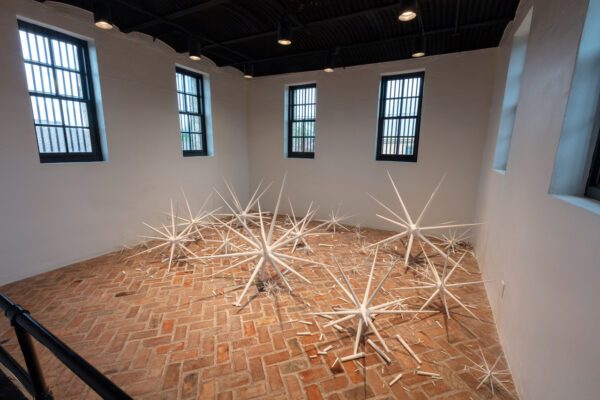
“Cam Schoepp: broken/time,” Cell Series exhibition installation view at The Old Jail Art Center, 2018
We do give them some direction by asking them to think about the context of the space, the history of the space, the physicality of the space, and ask them to try to do an exhibition that is talking about that or commenting on it or utilizing it. Most artists really take that to heart and do some interesting exhibitions and installations. From the outset, I find artists that I think can work with the space — just because you’re a good artist doesn’t mean you’re good for the Cell Series.
The cells are also physically challenging spaces, just because of the in/out stairway and all the windows But I think artists take that to heart and really love the challenge of using the space.
BZ: What has the response from the community been like during your time at the Old Jail? Albany is a town of not even 2,000 people, and as you’ve said, the Old Jail isn’t the typical small town community center art space.
PK: I think there are people who have been coming to the museum since 1980 who are used to coming and being challenged by the work. Our founders wanted to show people new things, too. I have to kind of walk a tight rope of trying to challenge visitors while also including the people who live in this community. But I also don’t want to do something that’s going to offend somebody. While I’m not going to do anything that’s going to embarrass our organization, I think I do push the envelope enough to challenge.
Some attendees are going to see things they’ve never seen before. And most of the time people are very receptive — it’s very surprising. Like, there are things that I think are going to really put people off. But then when they come in, they love it; it’s the greatest thing they’ve ever seen. So I can’t predict outcomes. If I do an exhibit that I think people are going to really love, sometimes it gets a lukewarm reception. And then other times when I’m really doing something crazy, people just love it.
Oftentimes the shows go back and forth: one exhibition will be kind of tame, and then the next one will be a little more challenging. So while I’m kind of appeasing different audiences with different shows, I’m never going to do an exhibition just to appease people and make them feel comfortable.
BZ: No cowboy painting shows?
PK: Well, if it’s a cowboy painting, it’s going to be something that you’re not going to see at a cowboy-type museum. Sometimes I do pick works that really kind of comment on Western heritage, but they’re not shows of Western art. To me, Western art is like fantasy art, because it doesn’t exist, or it never existed. I’m not talking about Remington and Russell and painters like that, but rather the contemporary artists who doing Western art — it seems very foreign to me and don’t really understand what the appeal is.
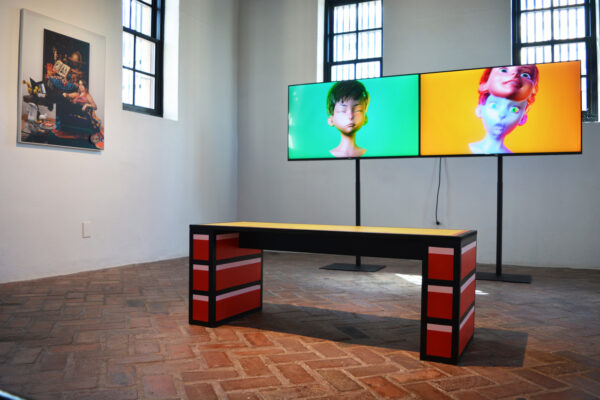
“Kris Pierce: A Ghost in the Attic,” Cell Series exhibition installation view at The Old Jail Art Center, 2019.
BZ: More broadly, what’s it like to run an art space in a smaller, more remote place that is itself a kind of destination for visitors?
PK: A normal, pre-COVID walk-in visitor number for us was 12,000 people a year. But I will digress a little bit and say that our education outreach reaches an equal or a greater number of students. So those are counted separately. But while 12,000 does sound like a lot, some days it’s very lonely around here [laughs]. Because it is a two-hour commitment to get here from Fort Worth, or three from Dallas, or six from Houston.
Despite our remoteness, it is really surprising the number of visitors we get from out of state and from different countries. There are people from England and Germany and Japan and Korea — it is really fun to see these people find out about us and to have them come in and visit. They have no idea that this even exists in a small town of 2,000 people. As for our local visitors, we have our regulars.
The frustrating part (I’m sure every museum feels this frustration), is that there are people who live in their communities or cities who have never walked in the door of their museums. I can’t fathom how somebody who’s lived here their entire life have never come into the Old Jail. Or, similarly, there are people in Houston who have never been to the Menil Collection, but that happens. Museums are an acquired taste. Sometimes there’s apprehension around them. Again, it’s a different cup of tea for some people.

“Camp Bosworth: Borderline Greatness,” Cell Series exhibition installation view at The Old Jail Art Center, 2014
BZ: It’s so interesting to hear that from your perspective. I feel like oftentimes, when people living in big cities think about their museums, they think, “oh there are a couple million people who live here, so it makes sense there are people who have never attended.” But whenever people in big cities think about somewhere like Albany, they’re like, “well, what else is there to do?”
This is just big city perception, of course. But the root of it is much deeper. Like you’re saying, it’s a human thing. It’s something we’re going to have everywhere, just at different scales. Like in Albany, there is a percentage of the total population that hasn’t been to the Old Jail. And I would imagine that percentage is kind of comparable to that of people in other cities who haven’t been to their local arts institutions.
PK: Oh yeah. Most definitely. One of the funniest stories I have is when I hadn’t been working here very long, I was sitting at the front desk and a lady stuck her head in the door and said, “what is this place?” And I said, “it’s an art museum.” She goes, “oh, I’ve been in one of these before,” and shut the door and walked off [laughs].
BZ: That’s so good.
PK: Yeah. And then we do have visitors who come in and actually are looking to visit their brother or their cousin in jail. So we have to break it to them — this is not the jail. It’s the Old Jail.
BZ: Again, that’s such a unique problem to y’all.
PK: I guess it’d be sort of like at the Mattress Factory [an art space in Pittsburgh], people coming in to look for a mattress.
BZ: In addition to running and curating the Old Jail, you’re also an artist. You studied art and have made art your entire career. You also had a wonderful show not too long ago at the Galveston Artist Residency, and another at Blind Alley Projects in Fort Worth.
I feel like a lot of people reading this live in larger cities; they’re used to having openings to go to every week. So I want to know, for you, what it is like to be an artist and be located fairly far away from a critical mass of artists? Or, maybe I should say from a larger group of artists, because there are other artists who live in Albany.
PK: Well, it definitely is a challenge to have an art career and live here, but I’m in a pretty good place in that I don’t need a lot of validation to do what I do because I don’t depend on the sales of my art to support me. I’ve never had that mindset. I’ve always had full-time jobs and then have done art in my spare time.
It’s kind of “out of sight out of mind” in the art world. If you’re not in a metropolitan area, a curator’s not going to drive two hours to come to do a studio visit. So, to a certain degree that has kind of hurt my career, which is okay.
It was my choice, though. I do as much as I can try to go to openings in Dallas and Fort Worth. But again, the older I get the less interested I am in doing that. Where I am in my career, I think I’m okay with being isolated and being able to go in the studio and do what I want to do and not have to be bothered by the market or anything like that. I’d be lying if I didn’t want to exhibit more. But that’s really not my incentive. I’m trying to concentrate on the quality of the work and on making meaningful work.
I can see that for somebody who’s young in their career, it would be a challenge for them to live in a more remote town. There’s an idea that you have to be within that realm of what’s going on in a metropolitan area to be really kind of seen.
BZ: Do you think that you’re more productive, in a sense, because there are fewer distractions? I’m trying to ask this question without playing into the stereotype of life being easy and carefree in nonurban places. But, not being in a major urban center where there’s a ton of other art stuff to easily drive to, do you find yourself having more studio time or being able to focus more on your own work?
PK: Well, I used to be a very prolific artist. And again, I’m at a certain age where I’ve realized that’s not really what I need to be doing. I need to be working on the quality of the work and what I’m saying and those kind of things. So my mindset has changed, and I’m in the studio as much as I need to be. And it’s a discipline that I have, I guess, perfected over my entire career, because as I mentioned, I’ve always had a full time job.
I’ve always been kind of in the studio working, but when I moved to Albany, it was a whole other thing. It’s like I have to be even more motivated and more disciplined to get in the studio and produce. But again, if I don’t have an exhibition coming up, I’m really tinkering and trying to perfect things and come up with projects that don’t really depend on a traditional art gallery or anything like that.
There are a few projects I’ve done — there’s one at an abandoned hotel. It’s called Uninvited Guests. So I found an abandoned hotel nearby (I won’t mention the town) and I did an installation of my work throughout the building. It’s a pretty awesome space, but it’s completely dilapidated and junked up. I did the installation with the idea to leave the works and see what would happen. My hope was that the works would disappear — and it actually happened! That was really part of the concept, that I would have another realm of collectors who have my art, but I don’t know who they are. These are the kind of fun things I do because I don’t have a venue to show my work; I’m creating my own venues.
I think perhaps it’s also a response to the fact that I do work in an institution — maybe I want to show art in a non-traditional setting. So anyway, these kinds of ideas about venues come out of me being in Albany. Does the work have to be in an institution, or can it be in an empty Dairy Queen or something like that?
BZ: That’s really cool. I want to slightly switch gears and ask about Albany’s artistic community. How have you seen Albany’s artistic community/art scene/community of people who are creative — whatever you want to call it — change over the last 30 years?
PK: I think as far as visual arts goes, it’s stayed pretty consistent. There are maybe one or two local artists in this area; Abilene has a pretty active art scene, but is 30 miles away. But Albany is really more of a performing arts community. For example, there’s The Fort Griffin Fandangle performance that happens every June — a locally-produced performance that’s been going on for 75 years or something like that. That’s kind of the center of the performing part of Albany. And we do have a lot of musically talented people in town. We have a local theater and there are a lot of theatrical productions, too. So as far as the arts goes, it really kind of encompasses all those, and dance. There’s a lot of dance that’s taught and performed here. That has been very consistent over the years.
How Albany kind of works is you grow up here, you move away, you have kids, and then you come back; it’s a cycle. So a lot of people are starting to come back, and we have a young group of people who are trying to propagate more music and performances and other venues, potentially for the visual arts. But we’re kind of working on those. As far as visual art, we really need a gallery or something to augment the Old Jail, but that’s difficult because of real estate.
As opposed to other small towns, we don’t have any empty buildings. I would love to see more artists move here. It’d be a great place if you could find a studio — it’s only two hours away from Fort Worth and it’s a getaway. But again, going back to the real estate issue of trying to find affordable working space for artists, it is difficult.
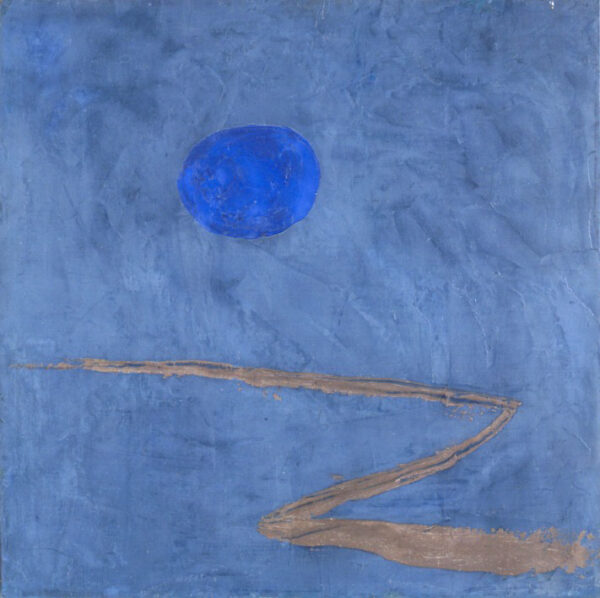
Paul Klee, “Der Weg ins Blaue (The Path into the Blue),” 1934, encaustic on canvas mounted on board. Collection of The Old Jail Art Center, Gift of Bill Bomar, 1991.002.
BZ: Is there anything I haven’t asked about Albany, you, or the Old Jail that we should know?
PK: Some people are curious about how we got started and why we’re so successful. And I have to give a lot of credit to the fact that the museum started at the right time with the right people and with the right amount of money. And I think that’s continued to be true. We have a fantastic board that’s very supportive of what we do and that financially supports us, not only locally, but throughout Texas. And folks who are in Fort Worth and Austin and who have foundations — they’re very supportive of our great staff. We also have continued membership support; we’ve been hitting on all the right cylinders at this point. We also have a fantastic endowment that is always helping us.
These ingredients have really made for past success, current success, and hopefully future success. I know other people from smaller towns who want to start an art center, and I try to tell them you need to have those three components — the right people, money, and support. The success of this institution is really an anomaly, I think, for a small town. It is a jewel, as they say [laughs].
BZ: I have one last question: What’s your favorite piece in the Old Jail’s permanent collection?
PK: Oh, gosh. Well, that’s funny because it changes from month to month. I’ll be walking through the vault and I’ll be like, “oh wow. That’s a great piece.”

Mel Ziegler, “Untitled #2,” 1999, antique display case filled with straw. Collection of The Old Jail Art Center, Gift of Burt Butler Foundation and Talley Dunn Gallery, Dallas, 2022.001.
BZ: Then what is it right now? Maybe that’s a better question.
PK: It’s probably something on view. I always go back to our Paul Klee. I mean, I would say our Paul Klee right now, but again, if you asked me the same question in a week, I’d probably come up with something else.
Okay — I might augment my answer. I have a second favorite piece that we recently received as a gift. It’s a Mel Ziegler sculpture that’s a large cabinet completely filled with hay. I saw the piece before it came into our collection, and I’ve always loved it.


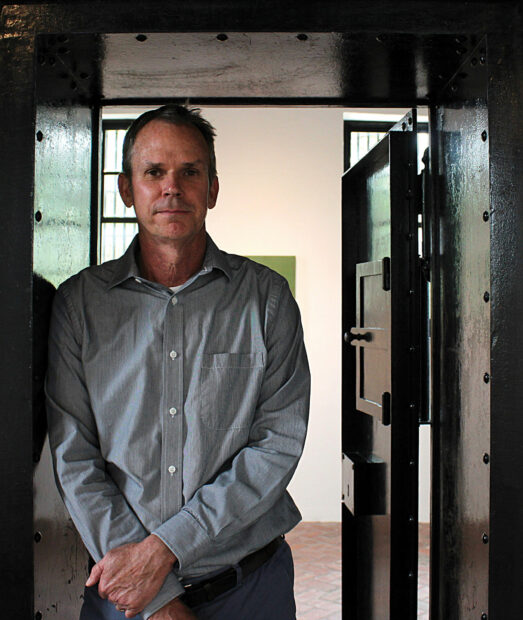

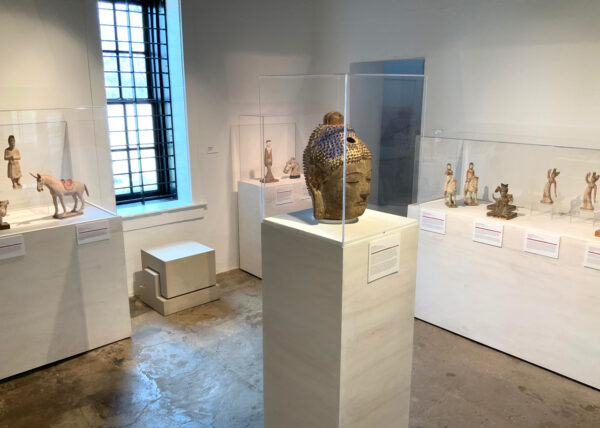
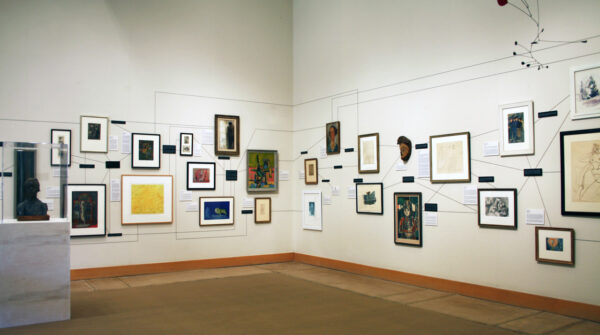
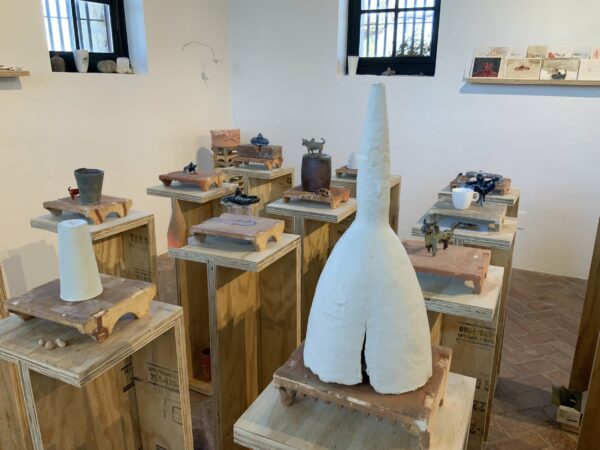
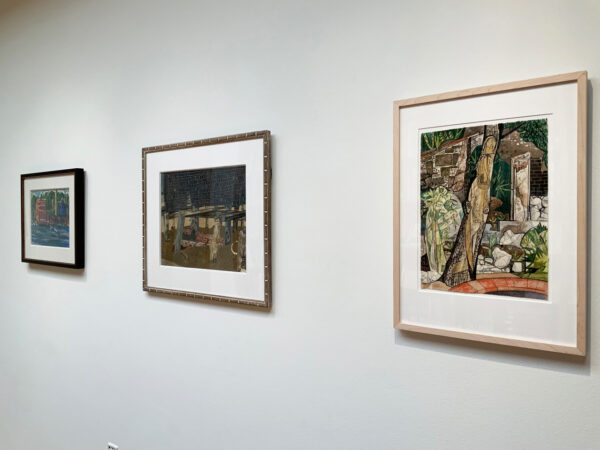
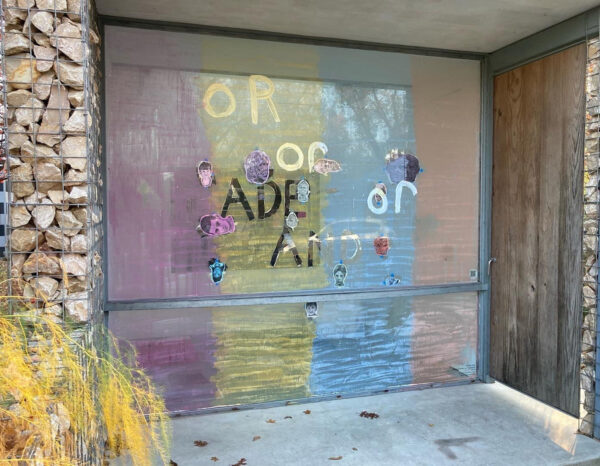
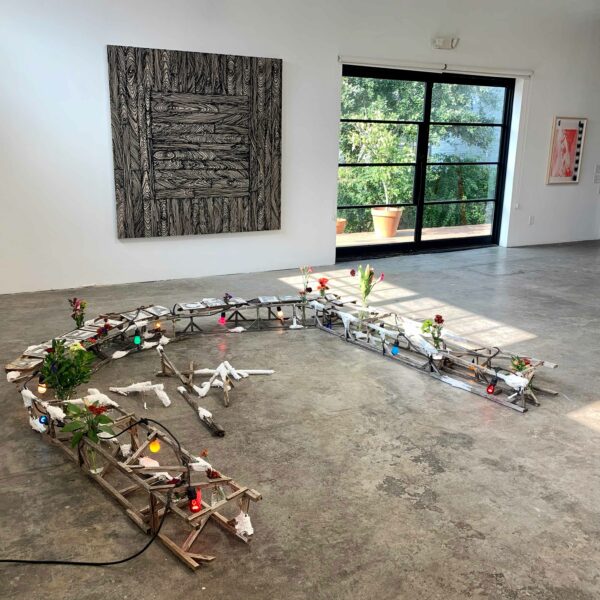
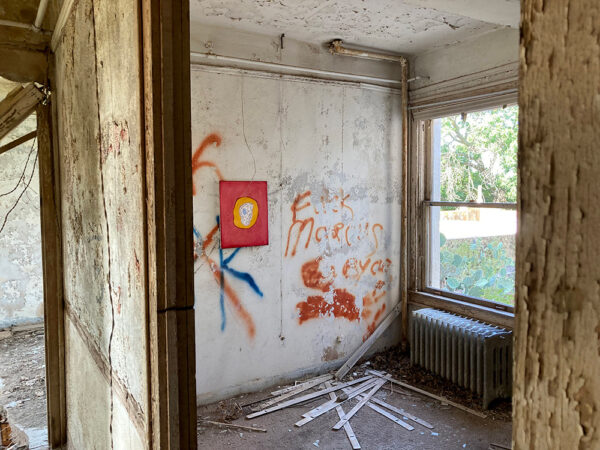

5 comments
Thanks for the inspiring interview. I am embarrassed that I have not made the trip. It sounds like a fascinating place, I will pick a date to explore it’s exhibitions. Any air b&b recommendations?
Best Texas treasure museum and and Texas treasures in Pat and Amy Kelly too! What they and this museum do is so amazing!
The late Clint Wilhour referred to the OJAC as the “unknown jewel of Texas art museums.” He was correct.
We are soooo proud of The Old Jail Art Center and especially proud of Amy & Pat Kelly and the fabulous Old Jail staff. The staff is low key but high energy and moves mountains to bring exceptional learning opportunities to school children in Texas, the US and even France through internet connections. And the archives building addition specializes in preserving the pioneer history of Shackelford and the surrounding counties. The Old Jail is free to the public Tuesday through Saturday every week. It must be on everyone’s bucket list! (I am a very proud Trustee)
Spring Break then summer…want to see. Planning now because of this wonderful interview. Love that the Old Jail Art Center celebrates rural life and present culture.